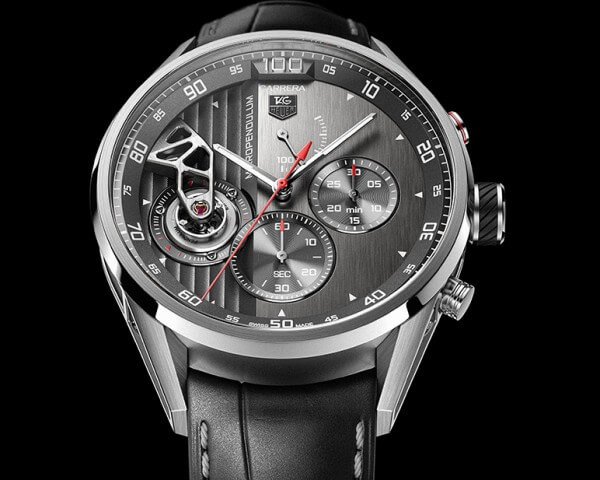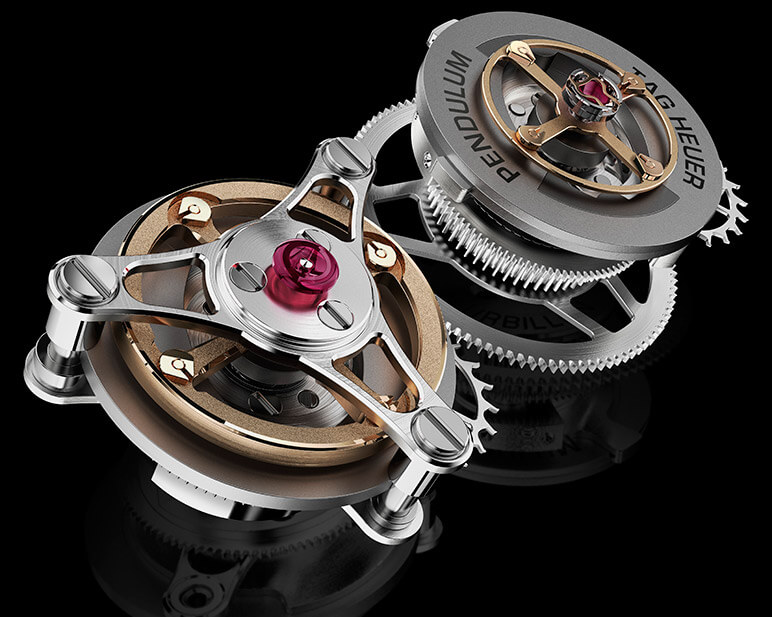The V4, Mikrograph, Mikrotimer, Mikrogirder and now Mikropendulum are, respectively, the first watch with a belt-driven transmission, the first chronograph beating at 50 Hz (360,000 vibrations/hour), the first chronograph beating at 500 Hz (3.6 million vib/h), a chrono beating at 1,000 Hz (7.2 million vib/h) and winner of the Aiguille d’Or at the 2012 Grand Prix d’Horlogerie de Genève, and the first ever magnetic escapement. TAG Heuer has certainly lived up to its name of late, TAG being an acronym of Technologie d’Avant-Garde. And it’s all down to Guy Sémon, Vice President of Science and Engineering at the head of the brand’s R&D. Since his arrival, this physicist, former test pilot and university lecturer has instigated a fundamental scientific approach to research that has resulted in a succession of game-changing innovations. At Baselworld, he explained the finer points of the Pendulum, the first magnetic escapement for a mechanical watch.

Permanent magnets
The Pendulum was first seen as a concept watch in 2010. The principle is that the oscillations of the balance wheel result from magnets attracting and repelling rather than the expanding and contracting of a balance spring. The prototype worked but was thrown off-kilter by temperature variations in particular. Guy Sémon and his 52-strong R&D team found a way to control magnetism on a very small scale to generate perfectly regular frequencies of up to 50 Hz… for now.
The Pendulum, like a traditional oscillator, comprises an axis supporting the balance wheel. This balance staff is divided in two lengthways, with a positive permanent magnet on one half and its negative counterpart on the other. It is circled, at an infinitely tiny distance, by the stator, a metal ring set in the plate. This magnetic ring is similarly divided into positive and negative separated by a neutral zone. When the balance staff is displaced from its equilibrium position, a repulsive force generates the same torque as would a conventional balance spring.
A fine-tuned alloy
So much for the principle; Guy Sémon and his team then had to overcome two major obstacles, namely variations in temperature and maintaining regular torque to ensure regular oscillations. The temperature problem was resolved by developing an alloy from rare-earth metals: samarium cobalt for one set of magnets, gadolinium samarium cobalt for the other. These three metals each play a different role. Cobalt and samarium are ferromagnetic and produce extremely powerful and stable magnets. They are taken to saturation under a magnetic field in excess of one tesla, which is one hundred thousand times the strength of the Earth’s magnetic field. This aligns all the atomic spins (a spin being a fundamental element of any particle). Reaching this maximum level produces a permanent magnet. But every magnet has a flaw: its field strength diminishes as temperature increases. The higher the temperature, the more the particles vibrate, causing magnetic field strength to diminish, sometimes completely. The temperature at which a magnet loses all its strength and becomes diamagnetic is called the Curie point.
TAG Heuer’s engineers counteracted this by adding gadolinium to the alloy. Its Curie point is 20°C, meaning it easily loses its magnetic properties in an everyday environment. The advantage for the Pendulum system is the cancelling effect this has on cobalt and samarium, as it limits their magnetic strength. The three metals balance each other out in a way that is unaffected by temperature. All that remained was to identify the right proportions for the required magnetic strength: 56% cobalt-samarium and 44% gadolinium for stable field strength over a temperature range of -20°C to +70°C.
Controlled force
The second challenge was to maintain regular force. Unlike a conventional balance spring, magnetic field is non-linear and inconstant, whereas isochronism is dependent on regularity. The task facing TAG Heuer was to precisely define the shape of the stator that would generate constant, linear torque when the balance staff rotates.
Guy Sémon’s team defined this optimal morphology using advanced physics and mathematical theorems (topology optimisation based on genetic algorithms with numerical finite element methods). The shape is directly determined by the frequency at which the oscillator must vibrate. At the present time, the lowest frequency is 12 Hz with a constant amplitude of 70° compared with an average 320° with a conventional system. While the maximum frequency has yet to be defined, the production model functions perfectly at 50 Hz to measure 1/100th of a second.
Production and commercialisation
The next step was to take this invention beyond the concept stage and into production. The magnetic alloy is supplied by a specialist firm in the United States. Delivered as sheets, it is machined in Besançon, France, by wire electric discharge (EDM). The wire used has a diameter of 10 microns. As Guy Sémon points out, dimension tolerances for the thickness of the magnets are ten times greater than for a conventional balance spring, where an error of 0.1 micron causes variations in rate of several hundredths of a second per day.
The fifth in a line of fundamental innovations by TAG Heuer, the Pendulum system comes to market in a timepiece that will retail at around CHF 35,000. The Carrera MikropendulumS concept watch has a dual chain architecture with a separate gear-train for the time and chrono functions. Both use a Pendulum tourbillon escapement with a 12 Hz frequency for the time and 50 Hz for the chrono. The Carrera Mikropendulum production model uses a COSC-certified, conventional balance and spring regulator beating at 4 Hz for the time and a Pendulum escapement beating at 50 Hz for the chrono.














